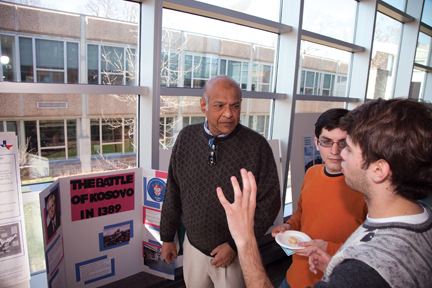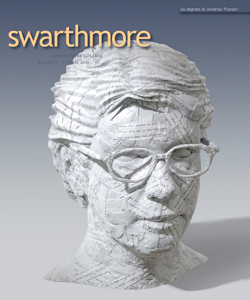Misunderstanding History

Professor Sudharshan Seneviratne (above, left) assigned the students of his Politics of the Past course to create posters depicting issues surrounding ownership and interpretation of the past from various periods and countries. A March exhibit in Eldridge Commons stimulated reflection and lively discussion among visitors. “Heritage and liberal arts are gifts to humanity,” says Seneviratne. “So it’s incumbent on us to pass the best of what we do to the next generation.”
When Sudharshan Seneviratne, a professor of archaeology at the University of Peradineya, Sri Lanka, (listen: Seneviratne’s lecture) first visited Swarthmore in 1990 to give a talk, he found the area around Parrish Hall thronging with students, faculty, and staff members protesting against the Gulf War. Although his talk had to be postponed until later that day, far from being upset by the disruption of his schedule, Seneviratne—then a Visiting Fulbright Professor at Cornell University—was impressed and delighted by the community’s enthusiastic antiwar stance.
“People are unbelievably engaged here,” he says.
Seneviratne, also director general of the Central Cultural Fund—a custodian organization for UNESCO World Heritage sites—is back at Swarthmore this year as the Cornell Distinguished Visiting Professor in the department of religion. His fall course Buddhist Ideology and Social Response focused on the multifunctional role of Buddhist ideology over the last 3,000 years with respect to social legitimacy, economic enterprise, state-monastery power dynamics, artistic expression, and militant response to colonialism. The students explored its impact on sixth-century B.C.E. urbanism and empire systems in North India; mercantilism in Central and South Asia in the first century B.C.E.; monastic feudalism in Sri Lanka; and 19th- and 20th-century colonialism and postcolonial nationalism of South Asia.
“I think the students thought I was going to teach them about Buddhist philosophy—the romanticized notion of Buddhism that is generally known in the West,” Seneviratne says. “But I gave them an entirely different picture of how religious and social ideologies evolve over time, how very simple initial teachings become institutionalized according to demand. You have an original, pristine ideal form, but anyone who wants to use it in a certain way will do so. Really, the flexibility of any religion is the secret to its survival.”
Several of the students who attended Seneviratne’s fall class also enrolled in his spring course Politics of the Past, which is cross-listed in classics and peace and conflict studies. Examining case studies from around the world, the class discusses ownership of the past—“who has the right to own it, interpret it, whose past are we talking about, and how is the past linked to and an intrinsic part of the present,” Seneviratne says. Museums come under scrutiny. “Whose histories are being shown, and whose are left out?” he asks.
“We also examined to what degree the past’s heritage can be used for conflict resolution,” he added.” In Sri Lanka, for example, he says, a bloody war imposed 30 years of pain and suffering on his people.
“Thousands died because they misunderstood history—with imagined communities and political ownership deduced from the past and used to legitimize power over other people,” he says. “We need healing processes—not just conflict resolution but reconciliation.” He mentions South Africa’s Truth Commission and his own country’s Truth and Reconciliation Committee.
“Both courses were problem-oriented, issue-related, and very demanding,” Seneviratne says. “I pushed the students to work at a graduate-course level, and they stood the test really well.” He is grateful to the College for support that allowed him to invite a variety of scholars from related disciplines to speak in his classes.
This type of far-reaching, multidisciplinary, liberal arts education is dear to Seneviratne’s heart—as is his passion for heritage, which he defines as a combination of culture that is nationally inclusive of all ethnic groups, custodianship of the past, environmental preservation, and looking forward to future generations.
 Email This Page
Email This Page